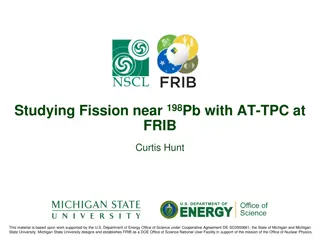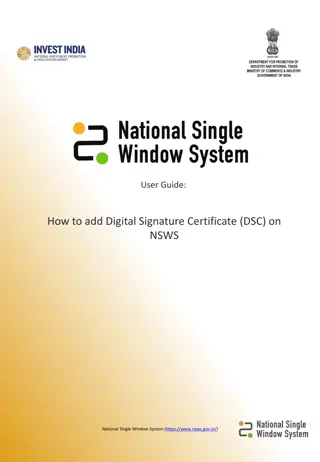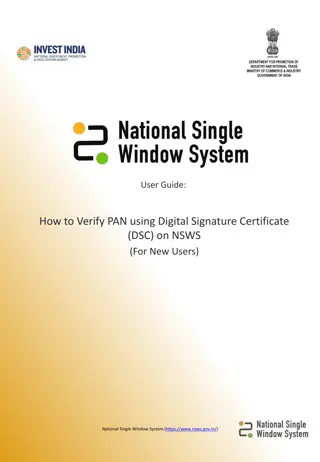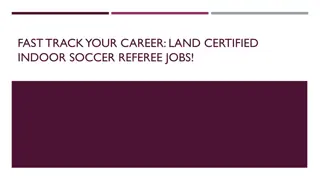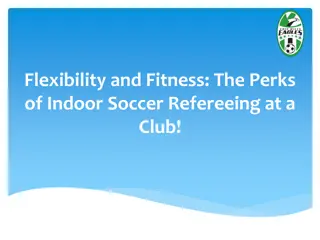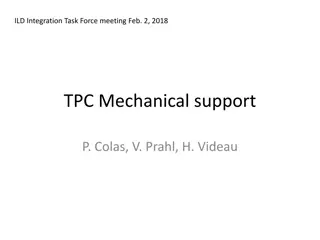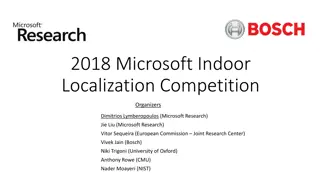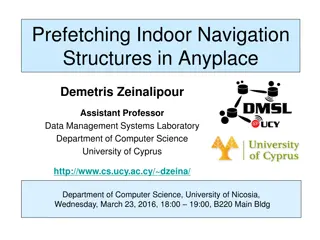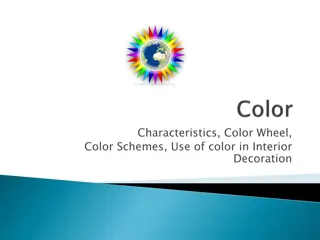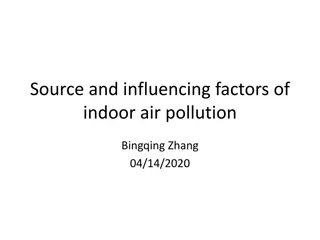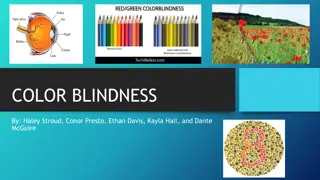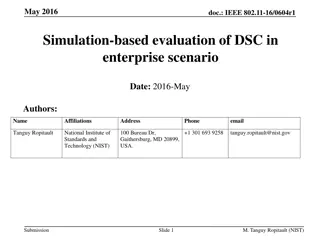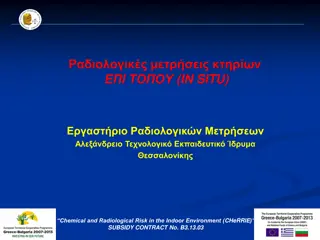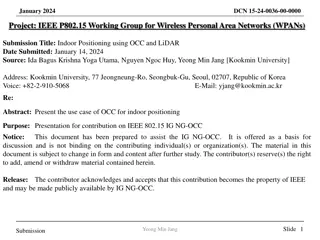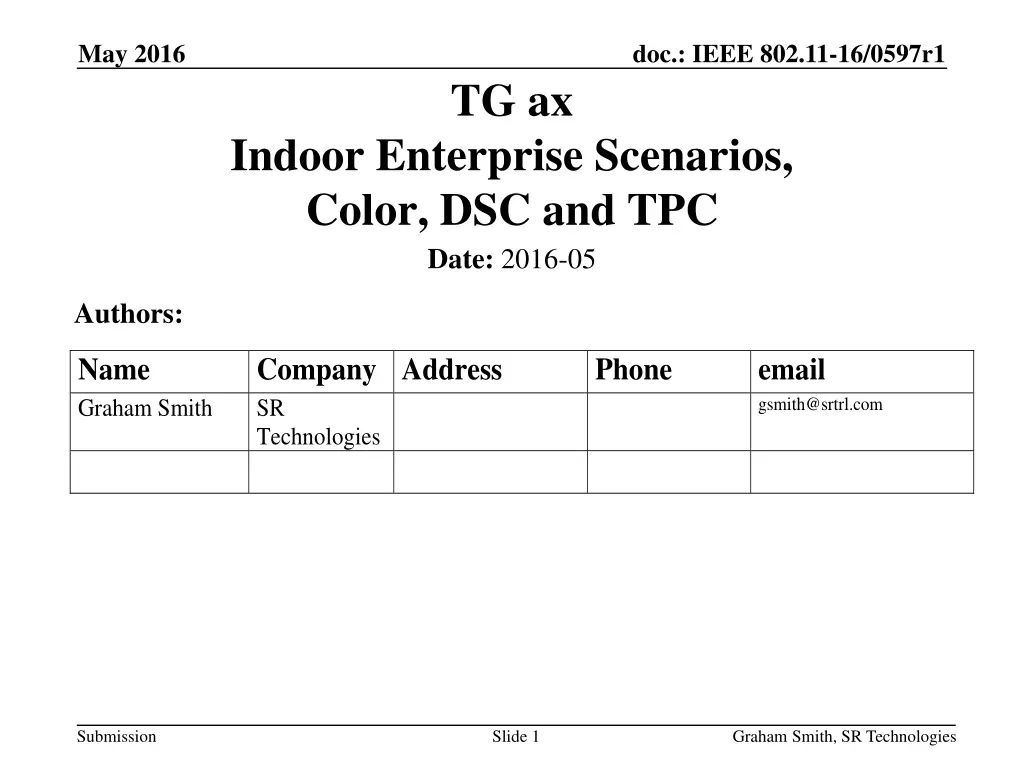
IEEE 802.11-16 Indoor Enterprise Scenarios Analysis
Explore the utilization of DSC, Color, and TPC in indoor enterprise scenarios based on IEEE 802.11-16 standards. Examination includes OBSS, spatial reuse, and interference evaluation across different channel scenarios. Detailed insights provided by Graham Smith from SR Technologies.
Download Presentation

Please find below an Image/Link to download the presentation.
The content on the website is provided AS IS for your information and personal use only. It may not be sold, licensed, or shared on other websites without obtaining consent from the author. If you encounter any issues during the download, it is possible that the publisher has removed the file from their server.
You are allowed to download the files provided on this website for personal or commercial use, subject to the condition that they are used lawfully. All files are the property of their respective owners.
The content on the website is provided AS IS for your information and personal use only. It may not be sold, licensed, or shared on other websites without obtaining consent from the author.
E N D
Presentation Transcript
May 2016 doc.: IEEE 802.11-16/0597r1 TG ax Indoor Enterprise Scenarios, Color, DSC and TPC Date: 2016-05 Authors: Name Graham Smith Company Address SR Technologies Phone email gsmith@srtrl.com Submission Slide 1 Graham Smith, SR Technologies
May 2016 doc.: IEEE 802.11-16/0597r1 Background DSC, Color and TPC have all been proposed for spatial reuse. The OBSS situation is fully examined based upon the two indoor enterprise scenarios The Indoor Enterprise scenario is examined for two rooms with the 4CH case and the 9 channel case The Indoor cell enterprise scenario is examined for two cells with the 3CH and 7 channel cases. Legacy, Legacy/TPC, Color, Color/TPC, DSC, DSC/TPC and DSC/ TPC one are all examined. Results show blocking and sharing and a figure of merit is used for comparison Submission Slide 2 Graham Smith, SR Technologies
May 2016 doc.: IEEE 802.11-16/0597r1 Topography of Indoor Enterprise 20m 20m AP Layout 4 channels We examine just this case 20m 29m Submission Slide 3 Graham Smith, SR Technologies
May 2016 doc.: IEEE 802.11-16/0597r1 4 Channel re-use AP to STA -45dBm AP to AP -64dBm STA to STA -77.5dBm ALL STAs and APs are overlapping Submission Slide 4 Graham Smith, SR Technologies
May 2016 doc.: IEEE 802.11-16/0597r1 Each of the 64 (DL) STAs has 64 potential interfering STAs (UL) Total links = 4096 STA and AP will transmit if CCA or color checks out. (Reciprocal for other AP) DL AP Transmits if CCA or color checks out SIR >20dB for success Wanted DL each of 64 DL STAs has one potential interfering AP DL Total Links = 64 Each of the 64 UL STAs has 64 potential interfering STAs (UL) Total links = 4096 STA and AP will transmit if CCA or color checks out. (Reciprocal for other STA) UL SIR >20dB for success Wanted UL STA Transmits if CCA or color checks out each of 64 UL STAs has one potential interfering AP DL Total Links = 64 Submission Slide 5 Graham Smith, SR Technologies
May 2016 doc.: IEEE 802.11-16/0597r1 9 CH Scenario 20m AP Layout 9 channels -73dBm -45dBm AP to AP -70dBm APs and All STAs are Overlapping Submission Slide 6 Graham Smith, SR Technologies
May 2016 doc.: IEEE 802.11-16/0597r1 Indoor Cell enterprise scenario 10m 24 STAs per cell 3CH scheme 7CH scheme Submission Slide 7 Graham Smith, SR Technologies
May 2016 doc.: IEEE 802.11-16/0597r1 10m DL Each of the 24 (DL) STAs has 24 potential interfering STAs (UL) Total links = 576 3CH scheme each of 24 DL STAs has one potential interfering AP DL Total Links = 24 STA and AP will transmit if CCA or color checks out. (Reciprocal for other AP) 10m UL Each of the 24 (UL) STAs has 24 potential interfering STAs (UL) Total links = 576 3CH scheme each of 24 UL STAs has one potential interfering AP DL Total Links = 24 STA and AP will transmit if CCA or color checks out. (Reciprocal for other STA) Submission Slide 8 Graham Smith, SR Technologies
May 2016 doc.: IEEE 802.11-16/0597r1 Methodology UL case example For each STA, the wanted UL RSSI at the AP is calculated, Pr wanted The RSSIs at the AP from all the other STAs and the AP in the other network are calculated, Pr unwanted The RSSIs at the transmitting STA, from all the other STAs and the AP in the other network are calculated, Pr interference If Pr interference < CCA Threshold, the STA will transmit If Pr wanted Pr unwanted > 20dB, SUCCESS If Pr wanted Pr unwanted < 20dB, BLOCKED If Pr interference > CCA Threshold, the STA will not transmit SHARE Blocked and Share terminology Blocked Transmission allowed when SNIR < 20dB, then both signals fail. Share Transmission prevented when SNIR < 20dB, standard contention. Submission Slide 9 Graham Smith, SR Technologies
May 2016 doc.: IEEE 802.11-16/0597r1 Methodology DL case example For each STA, the wanted DL RSSI from the AP is calculated, Pr wanted The RSSIs at the STA from all the other STAs and the AP in the other network are calculated, Pr unwanted The RSSIs at the transmitting AP, from all the other STAs and the AP in the other network are calculated, Pr interference If Pr interference < CCA Threshold, the STA will transmit If Pr wanted Pr unwanted > 20dB, SUCCESS If Pr wanted Pr unwanted < 20dB, BLOCKED If Pr interference > CCA Threshold, the STA will not transmit SHARE Blocked and Share terminology Blocked Transmission allowed when SNIR < 20dB, then both signals fail. Share Transmission prevented when SNIR < 20dB, standard contention. Submission Slide 10 Graham Smith, SR Technologies
May 2016 doc.: IEEE 802.11-16/0597r1 DSC and Color DSC (as per this analysis) STA measures the Beacon signal (wanted DL signal) and sets effective CCA Threshold 20dB lower. (DSC Margin = 20dB) AP sets its effective CCA level at 10dB below the lowest received wanted signal. DSC AP can prohibit DSC usage in its network. Color STA/AP looks at color bits in preamble to determine if signal is from same or inter BSS. If not same BSS, ignore signal. (A variation is to only reject if the inter BSS signal is lower than a set threshold) Submission Slide 11 Graham Smith, SR Technologies
May 2016 doc.: IEEE 802.11-16/0597r1 TPC from 15/1609 Adjusted TX_PWR = 15 RSSI + A -5<TX_PWR<15 dBm Assume the STA is close to the AP then RSSImax = -35dBm and TX_PWR = -5dBm TX_PWR = 15 (-35) + A = -5 Hence, A = -55dB For RSSI = -55dBm, TX_PWR = 15dBm Submission Slide 12 Graham Smith, SR Technologies
May 2016 doc.: IEEE 802.11-16/0597r1 Display of results Shared and Blocked 1. The number of Shared and Blocked links is calculated and the results tabulated. DL STAs , out of all the combinations (4096 for Indoor enterprise and 576 for cell enterprise) Due to interference from the STAs in other network # links Shared, # links blocked DL APs, out of all the combinations (64 for Indoor enterprise and 24 for cell enterprise) Due to interference from the AP in other network # links Shared, # links blocked UL STAs , out of all the combinations (4096 for Indoor enterprise and 576 for cell enterprise) Due to interference from the STAs in the other network # links Shared, # links blocked DL APs , out of all the combinations (64 for Indoor enterprise and 24 for cell enterprise) Due to interference from the AP in other network # links Shared, # links blocked Submission Slide 13 Graham Smith, SR Technologies
May 2016 doc.: IEEE 802.11-16/0597r1 Display of results Figure of Merit In order to produce a nice easy to compare illustration, a Figure of Merit is used. Success = 1, Shared = 0.5, Blocked = 0 Merit = (# links (# shared + # blocked) + # shared x 0.5)/(# links) Examples: Total # links = 4096, Shared = 4096, Blocked = 0 Merit = (4096 4096 + (4096 x 0.5))/4096 = 0.5 (i.e. all shared) Total # links = 4096, Shared = 0, Blocked = 0 Merit = (4096 0 + (0 x 0.5))/4096 = 1 (perfect, no OBSS) Total # links = 4096, Shared = 0, Blocked = 4096 Merit = (4096 4096 + (0 x 0.5))/4096 = 0 (totally blocked) Total # links = 4096, Shared = 768, Blocked = 698 Merit = (4096 1466 + (768 x 0.5))/4096 = .0.736 Submission Slide 14 Graham Smith, SR Technologies
May 2016 doc.: IEEE 802.11-16/0597r1 Results Indoor Enterprise 4CH, 15dBm, 7dB 4CH TX 15dBm, 7dB wall DL UL STAs AP STAs AP Merit Share 4096 1408 Block Merit Share Block Merit Share 4096 768 Block Merit Share Block Legacy Legacy/TPC Color Color/TPC DSC DSC/TPC DSC/TPC one 0.5 0 0 6 0 6 0 0 0.5 0.5 64 64 0 0 0 64 64 0 0 2 2 2 0 0 0.5 0 8 0.5 0.5 64 64 0 2 2 2 2 0 0 36 62 34 62 62 0.828125 0.998535 1 0.998535 1 0.875 0.904297 0.96875 0.969482 0.969482 0.96875 0.000732 0 0 0 0 0.96875 0.96875 0.96875 0.5 0.5 0 6 6 0 6 128 122 122 128 4090 0.4375 0.015625 0.453125 0.015625 0.015625 1024 DSC and Color are best TPC on STAs causes UL AP interference to block due to AP not TPC Submission Slide 15 Graham Smith, SR Technologies
May 2016 doc.: IEEE 802.11-16/0597r1 Results Indoor Enterprise 4CH, 18dBm, 3dB 4CH TX 18dBm, 3dB wall DL UL STAs AP STAs AP Merit Share Block Merit Share Block Merit Share Block Merit Share Block Legacy 0.5 4096 0 0.5 64 0 0.5 4096 0 0.5 64 0 Legacy/TPC 0.5 4096 0 0.5 64 0 0.574707 3484 0 0.5 64 0 Color 0.8125 0 768 0.65625 0 22 0.65625 0 1408 0.3125 0 44 Color/TPC 1 0 0 0.65625 0 22 0.65625 0 1408 0 0 64 DSC 0.8125 0 768 0.65625 0 22 0.73584 768 698 0.484375 22 22 DSC/TPC 1 0 0 0.5 64 0 0.65625 0 1408 0.171875 22 42 DSC/TPC one 0.561035 3584 6 0.5 64 0 0.09375 768 3328 0.171875 22 42 DSC is best all round TPC improves DL STAs TPC on STAs causes UL AP interference to block due to AP not TPC Submission Slide 16 Graham Smith, SR Technologies
May 2016 doc.: IEEE 802.11-16/0597r1 Results Indoor Enterprise 9CH, 18dBm, 3dB 9CH TX 18dBm, 3dB wall DL UL STAs AP STAs AP Merit Share Block Merit Share Block Merit Share Block Merit Share Block Legacy 0.5 4096 0 0.5 64 0 0.5 4096 0 0.5 64 0 Legacy/TPC 0.765625 1920 0 0.5 64 0 0.765625 1920 0 0.5 64 0 Color 1 0 0 1 0 0 1 0 0 1 0 0 Color/TPC 1 0 0 1 0 0 1 0 0 0 0 64 DSC 1 0 0 1 0 0 1 0 0 1 0 0 DSC/TPC 1 0 0 1 0 0 1 0 0 0 0 64 DSC/TPC one 1 0 0 1 0 0 0 0 4096 0 0 64 DSC and Color are best Spatial Re-use!!!! TPC on STAs causes UL AP interference to block due to AP not TPC Submission Slide 17 Graham Smith, SR Technologies
May 2016 doc.: IEEE 802.11-16/0597r1 Results Indoor Cell Enterprise 3CH, 15dBm, 0dB 3CH TX 15dBm, 0dB wall DL UL STAs AP STAs AP Merit Share Block Merit Share Block Merit Share Block Merit Share Block Legacy Legacy/TPC Color Color/TPC DSC DSC/TPC 0.5 0.5 576 576 0 0 0.5 0.5 24 24 0 0 24 24 0 0 0.489583 24 24 0 0.319444 0 0.110243 0.5 576 564 0 0.5 0.5 24 24 0 0 24 24 0 0 12 576 576 208 449 0.34375 0.770833 0.505208 0.78125 0 0 378 132 141 30 0 0 0 0 0 0 0 0 24 24 0 0 288 192 0.5 0.5 368 127 0.5 0.5 DSC/TPC one 0.5 576 0 0.5 24 0 0.317708 366 210 0.5 24 0 Legacy is best DSC is close second (Note: DSC can be disabled by AP if it recognizes such a situation) Particularly strong OBSS as cells adjacent to each other. Submission Slide 18 Graham Smith, SR Technologies
May 2016 doc.: IEEE 802.11-16/0597r1 Results Indoor Cell Enterprise 7CH, 18dBm, 0dB 7CH TX 18dBm, 0dB wall DL UL STAs AP STAs AP Merit Share Block Merit Share Block Merit Share Block Merit Share Block Legacy Legacy/TPC Color Color/TPC DSC DSC/TPC DSC/TPC one 0.5 576 264 0 0 0.5 0.5 24 24 0 0 0 0 0 0 0 0.817708 2 2 2 0.987847 2 2 0.720486 0.5 576 210 0 0 0 0 0 0.791667 0 0.041667 154 0.041667 0.5 0.5 0.75 24 24 0 0 2 2 2 0 0 6 0.770833 0.975694 0 0 0 0 0 14 0.916667 0 0.916667 14 0.916667 0 0.916667 14 0.916667 1 1 0 0 1 0 24 0.975694 14 0 14 4 1 1 22 22 0.975694 DSC is best. Spatial Reuse. TPC improves DL and UL STAs But blocks UL AP Submission Slide 19 Graham Smith, SR Technologies
May 2016 doc.: IEEE 802.11-16/0597r1 Results Indoor Cell Enterprise 7CH, 18dBm, 2dB 7CH TX 18dBm, 2dB wall DL UL STAs AP STAs AP Merit 0.770833 Share Block Merit Share Block Merit 0 0.635417 0 0.980903 0 0 0 0 0 0.958333 Share Block Merit Share Block Legacy Legacy/TPC Color Color/TPC DSC DSC/TPC DSC/TPC one 264 0 0 0 0 0 0 0 0.5 0.5 24 24 0 0 0 0 0 420 22 0 0 0 0 0 0 0.5 0.5 24 24 0 0 0 0 0 0 0 0 0 0 0 0 1 1 1 1 1 1 0 0 0 0 0 0 1 1 1 1 1 1 1 1 1 0 0 0 0 0 1 1 1 1 1 24 Assume a little obstruction loss and perfect Spatial Reuse with Color and DSC Submission Slide 20 Graham Smith, SR Technologies
May 2016 doc.: IEEE 802.11-16/0597r1 Discussion of results Enterprise DSC performs the best overall Color performs close to DSC TPC improves DL and UL STAs interference TPC blocks UL AP interference (AP not TPC) Devise a TPC method for the AP? Submission Slide 21 Graham Smith, SR Technologies
May 2016 doc.: IEEE 802.11-16/0597r1 Discussion of results Cell Enterprise DSC performs well in 3CH, but legacy is better Color performs bad in 3CH case TPC improves DL STAs interference DSC and color provide great spatial reuse for 7CH case Submission Slide 22 Graham Smith, SR Technologies
May 2016 doc.: IEEE 802.11-16/0597r1 DSC or Color? Color Provides improved OBSS performance UL and DL Will blockUL and DL overlapping packets rather than share. Only works if ALL STAs and APs in OBSSs have the feature Relies on the OTHER DEVICES having the feature as well Will NOT work with legacy OBSS STAs and/or AP. Note: Color was originally proposed for a particular PHY, so met the above requirements DSC Provides improved OBSS performance UL and DL Tends to share overlapping packets UL, blocks DL Works with OBSS legacy STAs and/or legacy AP Results presented are for the wanted BSS, other BSS can be legacy. DSC is implemented by the STA, can be independent There is an incentive for a STA to use DSC. Submission Slide 23 Graham Smith, SR Technologies
May 2016 doc.: IEEE 802.11-16/0597r1 TPC? TPC can improve STAs interference but unless APs also use TPC it results in blocking of the AP interference If overlapping network is not using TPC, then do not use TPC in the wanted network. All STAs and APs must use TPC for it to be effective No real incentive for a STA to use TPC as it as it makes the STA vulnerable. NOTE: A TPC scheme for APs may be possible, but still problem with legacy. Submission Slide 24 Graham Smith, SR Technologies
May 2016 doc.: IEEE 802.11-16/0597r1 Discussion and Conclusion Both Color and DSC provide improvements in Spatial Re-Use Color will not work until ALL STA/APs have the feature (designed for an independent PHY) Color is in the 11ax SFD TPC only works if ALL STA AND APs use the feature. If just STAs use TPC then results are worse. DSC with TPC is in the 11ax SFD DSC works, is completely defined, easy to implement and has more analysis than any other Spatial Reuse scheme. DSC presents a good incentive for a vendor to adopt. Does not rely on other STAs having it. Text for DSC has been proposed 16/0310r1. This presentation shows that overall DSC performs better than Color or DSC/TPC in the evaluated scenarios. Submission Slide 25 Graham Smith, SR Technologies
May 2016 doc.: IEEE 802.11-16/0597r1 Straw Poll DSC text should be incorporated into the Draft 11ax Amendment Note: 16/0310 may be used as a basis. Y N A Submission Slide 26 Graham Smith, SR Technologies

